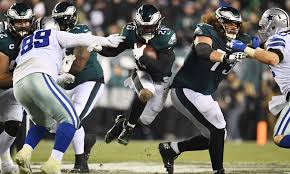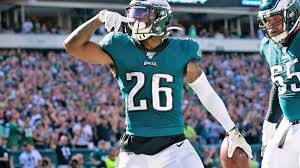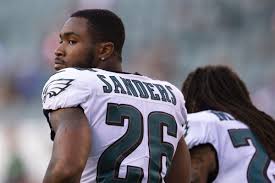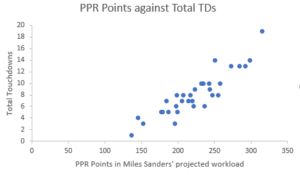Miles Sanders is an RB1. Or maybe he’s not. He’s being undervalued, or maybe it’s overrated? This offseason, the jury on Miles Sanders has ranged from RB5 down to RB18. To boil it down, Miles Sanders is probably good. Maybe.
But why? He was drafted 53rd overall out of Penn State and the expectations were high.
“Sanders has a good chance to be the most productive running back in this class”
Dynasty League Football expected him to be above Josh Jacobs, David Montgomery, and the rest of the 2019 RB class. But, after what we saw last year, were they right or wrong about Sanders’ potential?
Miles Sanders: Is He Overrated?
2019 Performance

Then, in his rookie season, Sanders played quite well. His 818 yards on 179 carries was good for 4.57 YPC was 16th among qualified rushers in 2019 (14th for RBs, thanks to Lamar Jackson and Josh Allen), and he finished right in line with Aaron Jones, Saquon Barkley, Ezekiel Elliot, and Dalvin Cook.
On top of that, Sanders showed off his receiving upside with 50 catches on 63 targets for 509 yards, good for 8.1 #yardsper target, which was third among RBs in 2019, behind Austin Ekeler and Dalvin Cook.
Sanders had 6 total TDs in the 2019 campaign, which has room for improvement, but there have been extremely fantasy-relevant players with fewer than that, the most notable being Leonard Fournette and Alvin Kamara’s 2019 campaigns, both finishing in the top 10 in PPR scoring despite finding the end zone just a few times apiece.
What are the problems for Miles Sanders?

So, why would Sanders, a 23-year old athlete with high draft capital, a strong pedigree, and an effective rookie season be ranked in the low teens, even being ranked 18th?
The biggest answer: Doug Pederson.
Doug Pederson & Runningback by Committee
The biggest knock on Miles Sanders for 2020 is that Eagles head coach Doug Peterson uses the running back by committee (RBBC), also known as the death to RB fantasy production. Pederson’s leading rushers since he took over the Eagles in 2016:
2016: Ryan Mathews: 155 carries, 35-percent backfield share, 4.3 YPC, 8 TDs
2017: LeGarrette Blount: 173 carries, 37-percent backfield share, 4.4 YPC, 2 TDs
2018: Josh Adams: 120 carries, 30-percent backfield share, 4.3 YPC, 3 TDs
2019: Miles Sanders: 179 carries, 39-percent backfield share, 4.6 YPC, 3 TDs
See Where Sanders Lands In Our 2020 RB Rankings!
Having no back top 200 carries is a huge detriment to Sanders’ upside, and severely limits the production he can put up in 2020 and beyond. But is the RBBC a strategy that Doug Pederson does by choice or necessity? None of the names on that leading rusher list are inspiring.
In 2019, Miles carried the ball 179 times, good for 39-percent of the team’s rushes, with Jordan Howard’s 26-percent second-most on the team. The other significant percentages were Carson Wentz at 14-percent and Boston Scott at 13-percent. Of Pederson’s four seasons in Philadelphia, Sanders’ 179 carries are the most any back has seen, and the 39-percent share is the highest percentage of backfield carries also.
Eagles 2020 Backfield
 Pederson himself has said that Sanders “is our No. 1… He’s ready to carry the load,” but he went on to say, “I think you’ve got to have a second or a third guy there to help him.” Based on these comments from Pederson, Sanders won’t be topping 300 touches any time soon, but what do Pederson’s comments mean for his touches?
Pederson himself has said that Sanders “is our No. 1… He’s ready to carry the load,” but he went on to say, “I think you’ve got to have a second or a third guy there to help him.” Based on these comments from Pederson, Sanders won’t be topping 300 touches any time soon, but what do Pederson’s comments mean for his touches?
Jordan Howard is gone now.
In his stead, the other heads of Pederson’s committee are Boston Scott and Corey Clement. Boston Scott had a sizzling December and rushed for 4 TDs on 38 carries during his final five games.
But Scott has never done anything else at the pro level, and it remains to be seen if his December was a mirage or if he is a diamond in the rough for 2020 fantasy owners.
The backs behind Sanders don’t challenge Sanders in talent.
Based on the personnel changes in the Eagles backfield and the comments made by Doug Pederson, it’s realistic to expect a slight uptick from his 39-percent rushing share from last season, putting Sanders in the 40-50-percent range.
However, the Eagles will see fewer rushing attempts. They had 454 carries in 2019, the 7th most in the league, and they brought in more receivers in the offseason, most notably Jalen Reagor in the first round of the draft. However, Doug Pederson loves a run-heavy offense, so we can expect to see close to 440 rushing attempts in 2020.
If Sanders does indeed see that slight uptick towards 45-percent of backfield carries, with similar receiving numbers, his 2020 workload could easily see 200+ carries and 60+ targets. What does that mean for his fantasy upside?
2020 Fantasy Football Outlook

Since 2011, there are 32 RB seasons with a workload of between 180-250 carries and 50-70 targets. This range encompasses the potential volumes that Miles Sanders sees in 2020.
Of those 32 seasons, the best was in 2019, Aaron Jones, scoring 314.8 PPR points and finishing 2nd in RB scoring, while the worst was 2012 Ryan Mathews, scoring only 136.9 points and finishing 30th in RB scoring.
But we’re less interested in the extremes and more interested in the averages. The average performance with that volume: 965 rushing yards, 44 receptions for 354 yards, 8 TTDs, 222.56 PPR points. How good is that?
Since 2011, the RB12 has a median of 216.1 PPR points. This maps out to 13.5 fantasy points per game. In a typical 12-team league, this is the minimum that a back can produce and still be considered an RB1, 13.5 PPR points per game, and 216 on the season. 222.56 is above that, so the average RB with Sanders’ expected workload is a low-end RB1.
The range of outcomes depends greatly on TD scoring, and the high-end of 300+ PPR points and a top-5 finish is within the realm of Sanders’ potential, but it is unlikely based on his volume.

What’s far more realistic is that Sanders has a yards per carry rate in the 4.5-4.8 range and scores 6-8 TDs, both numbers he hit last season.
For 2020, Miles Sanders projects in the low RB1 range, with 220-250 PPR points, depending on how many TDs he scores. This is worth picking up at RB10 prices and definitely at RB18, but not at RB6 prices. For RB6 prices, target a player who could finish 2020 as the RB6.
Make sure to follow Yards Per Fantasy expert @JoelSigrist






